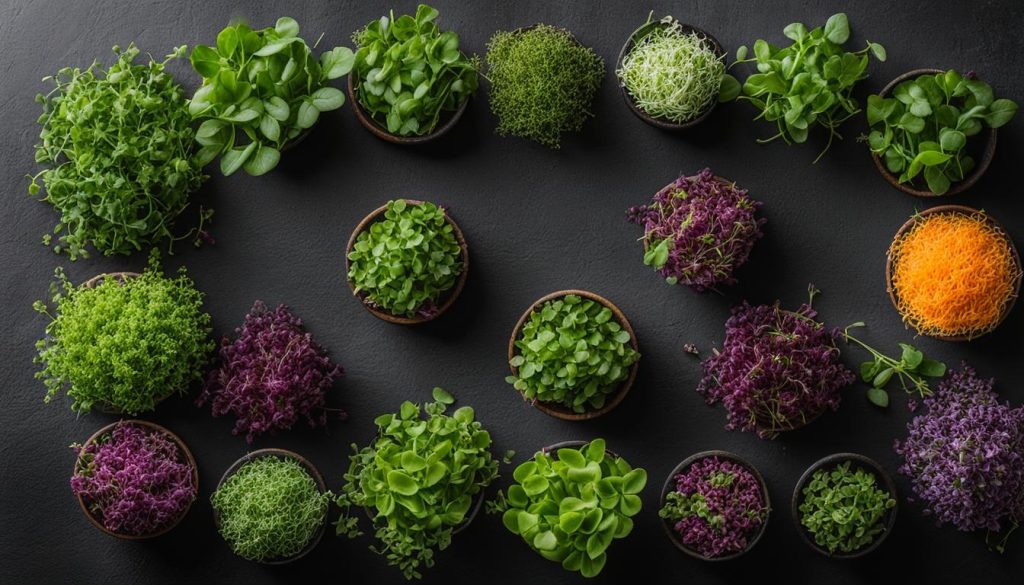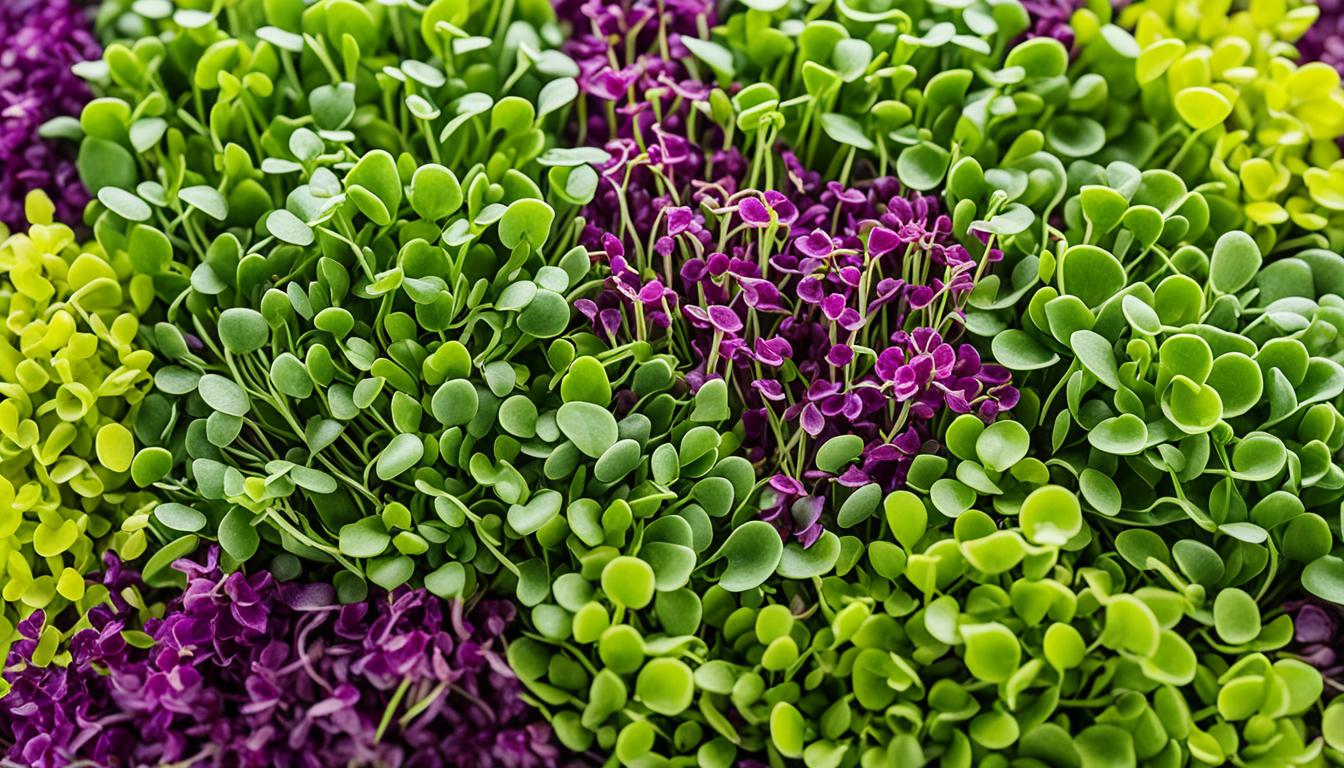Friendly and wholesome eating is on the rise, and so is the curiosity about the nutritional value of microgreens. This small but mighty food category has been gaining attention for packing a high nutrient punch within their tender leaves. But why is this significant? Are microgreens good for you, and if so, how can they contribute to your health and well-being?
The health benefits of microgreens are vast and encompass numerous dietary needs. These youthful versions of vegetables and herbs, barely 1–3 inches tall, punch well above their weight when it comes to nutrient content. Harvested right after germination, microgreens are bursting with vitamins, minerals, and antioxidants. They have been shown to contain, in some cases, up to 40 times higher levels of vital nutrients such as vitamins C, E, and K compared to their fully-grown plant relatives. Could this make them a worthwhile addition to your meals?
Incorporating microgreens into your diet can enhance the nutritional quality of your meals, adding both vibrant colors and rich flavors. With their promising health benefits and concentrated sources of essential nutrients, let’s delve into what makes these greens such a powerful element for maintaining good health.
Key Takeaways
- Microgreens are highly nutritious, offering a greater concentration of vitamins and minerals than mature greens.
- They are rich in antioxidants like vitamins C, E, and K, along with beta-carotene, with substantial health benefits.
- Including microgreens in your diet can boost intake of essential nutrients with minimal caloric addition.
- The variety of microgreens means a range of flavors and textures to enhance any meal.
- Research suggests that the nutritional value of microgreens may support overall health, adding to their appeal in a balanced diet.
Understanding Microgreens: What Are They?
Entering the world of microgreens introduces you to a fascinating realm of miniature greens. These nutritional powerhouses may be small in stature, but they’re bursting with flavor and potent health benefits. Incorporating microgreens into your diet is more than a culinary trend—it’s a stride toward wellness, leveraging the advantages of eating microgreens that come in an array of microgreen varieties.
A Brief Introduction to Microgreens
Microgreens are the young seedlings of edible vegetables and herbs harvested just after the first leaves have developed. They’re revered for their concentrated nutrients and have become synonymous with healthy, sustainable living. Each variety of microgreen, from tangy radishes to sweet peas, offers a unique flavor profile and a punch of color that can elevate even the simplest of dishes.
The Difference Between Microgreens, Sprouts, and Baby Greens
While sprouts are the initial stage of a plant’s life cycle, harvested before leaves appear, microgreens are the next step, picked after the first true leaves emerge. Baby greens, on the other hand, are older and larger but still immature plants, typically harvested before they have reached full size. Despite their small size, microgreens should not be underestimated; they pack a more intense flavor and nutrient concentration than both their sprout and baby green counterparts, providing a wealth of health benefits that contribute to their status as nutritional powerhouses.
Are Microgreens Good For You: The Nutritional Breakdown
Exploring the health benefits of microgreens reveals a fascinating nutritional landscape bursting with concentrated nutrients. These tiny greens pack a punch well above their weight class, making them an excellent candidate for anyone looking to enhance their diet with dense, health-promoting substances. One of the most compelling attributes of microgreens is their antioxidant content, which is notably higher than that found in mature leafy greens.
Microgreens are a cornucopia of essential minerals, including potassium, iron, zinc, magnesium, and copper. These minerals are not just present, but abundant, setting microgreens apart as a superior source of nutrition. For example, the iron in microgreens is not only vital for oxygen transportation in the blood, but it’s also more readily available for absorption due to the presence of Vitamin C, which is also found in microgreens.
The remarkable concentration of vitamins such as C, E, and K, alongside other valuable phytonutrients, lends microgreens their reputation as a powerhouse of health. Regular consumption can lead to a significant intake of these essential nutrients, contributing to overall wellness and protection against cellular damage caused by free radicals.
Indeed, including microgreens in your meals is more than just a gustatory delight—it is a strategic move towards fortifying your body. Just a handful of these verdant gems can elevate the nutritional value of a dish without resorting to large portions, making them not only a smart choice for those with health-forward goals but also for anyone looking to get the maximum benefit from their food.
Health Benefits of Microgreens: Beyond the Basics
The diminutive size of microgreens belies their massive potential for improving our well-being. Beyond adding a pop of color to our plates, microgreens and their benefits to health are the subject of increasing interest among nutritionists and health-conscious individuals alike. Delving deeper into their nutritional profile reveals how these tiny greens are playing a big role in promoting a healthier lifestyle.
Rich in Antioxidants: Combatting Oxidative Stress
These miniature greens are densely packed with antioxidants, including a range of polyphenols in microgreens. The impact of these compounds is significant, offering our bodies protection against oxidative stress, which is implicated in the development of many chronic diseases. By incorporating microgreens into our diet, we harness an easy and natural way of enhancing our body’s resilience against these threats.
Heart Health: How Microgreens May Help
The quest for a healthier heart also finds a friend in microgreens. Mounting evidence suggests these lush little leaves can aid in reducing factors that contribute to cardiovascular disease. By playing a role in lowering the risk of heart disease, microgreens like kale and arugula might just be the understated champions of heart health, helping to manage cholesterol levels and maintain healthy blood pressure.
Microgreens and Weight Management
For those pursuing weight management goals, the low-calorie yet nutrient-rich profile of microgreens is an exceptional dietary addition. They satiate the palate and the body with vitamins and minerals, without the added burden of excess calories. Because of this, microgreens offer an outstanding way to enrich our diet while aligning with weight management and overall health goals. Fenugreek microgreens, for example, have not only been linked to heart health but also to better metabolic function, proving that good things indeed come in small packages.
Advantages of Eating Microgreens for Digestive Health
Incorporating microgreens into your daily meals isn’t just a trend; it’s a health transformation with a significant focus on improving digestive wellness. Crucial to this process is the deep well of dietary fiber in microgreens that varies depending on the type, with standouts like arugula and mustard leading the pack. These miniature greens do more than add color and texture; they are essential for maintaining a healthy gut.

A diet rich in microgreens is a stride towards promoting regular bowel movements and fortifying gut health. The transition to a plant-based diet, reinforced by consuming microgreens, is a sure step towards a more balanced approach to eating. The fiber acts as a prebiotic, supporting the growth and activity of beneficial gut bacteria, which is critical for nutrient absorption and plays a role in staving off digestive disorders.
By embracing microgreens as a dietary staple, you’re not just taking a bite of green; you’re indulging in a practice that paves the way towards longevity and vitality. This is the kind of lifestyle choice that connects what you eat with how you feel, leading to a more conscious approach to nutrition. Ultimately, as they say, a balanced diet is a cornerstone of health, and microgreens play a starring role in this plant-based, fiber-rich narrative.
Nutritional Value of Microgreens: A Closer Look
Microgreens, the young seedlings of vegetables and herbs, have rapidly become a focal point in discussions about nutrient-dense foods. Beyond their delicate textures and vibrant colors, these miniature plants pack a substantial nutritional punch. Extensive studies contribute to a growing body of evidence that nutrient levels in microgreens surpass those found in mature leafy vegetables, illustrating the remarkable benefits of these tiny greens.
Consumers and chefs alike celebrate microgreen varieties for their concentrated flavors and nutrition. Each variety offers a distinct profile of concentrated vitamins in microgreens, minerals, and other beneficial compounds that contribute to a well-rounded diet.
Comparing Nutrients in Microgreens to Mature Plants
The comparison between microgreens and their mature counterparts is astonishing. Scientific research indicates that certain microgreens contain up to nine times the nutritional content of full-grown greens. This disparity highlights the density of health-promoting elements contained within the tender shoots of these plants. Integrating microgreens into meals can thus boost the intake of essential nutrients significantly more than one might achieve with larger portions of mature vegetables.
Key Vitamins and Minerals in Popular Microgreen Varieties
When exploring the array of microgreens available, some varieties emerge as nutritional standouts. For instance, red cabbage microgreens boast large amounts of vitamin C, while broccoli microgreens are laden with vitamin E. Radish microgreens are another nutrient treasure, with high levels of vitamin K and beta-carotene. Each variety contributes not only to the visual appeal of a dish but also to elevating the healthfulness with essential vitamins and minerals that our bodies require for optimal function.
Understanding the nutrient levels in microgreens and the array of available microgreen varieties allows individuals to make educated choices for incorporating these concentrated vitamins and minerals into their daily food intake. Recognizing microgreens as more than just garnishes, but as crucial components of a healthy diet, is key to harnessing their full potential for well-being.
Reasons to Consume Microgreens: Enhancing Your Diet
Embracing microgreens as part of your daily meals is a simple stride toward nutritional betterment. An amalgamation of remarkable health benefits and enchanting flavors, microgreens are set to revolutionize wholesome eating and bring vitality to your table.
Integrating Microgreens Into Daily Meals
Whether you’re tucking them into a crisp wrap or sprinkling atop a savory dish, integrating microgreens into your cuisine couldn’t be easier. They’re perfect for adding a burst of color and a peppery punch to your favorite recipes. Just imagine the satisfying crunch of kale microgreens in your next green smoothie or the subtle spice of radish microgreens elevating a classic garden salad. Tiny as they are, these greens pack a flavorful and nutritious wallop.
Microgreens as a Source of Dietary Fiber
Don’t underestimate these miniature greens; besides being nutrient powerhouses, microgreens are a fantastic source of daily dietary fiber. Consuming a variety of microgreens can help maintain a healthy gut, thus promoting better digestion and offering a feeling of fullness that aids in appetite control. By enhancing your diet with microgreens, you’re not only indulging in an array of delightful tastes but also fortifying your meal with fiber—essential for a balanced lifestyle.
Microgreens and Their Benefits to Health: Addressing Modern Diet Deficiencies
In an era where modern diet deficiencies are increasingly common, the integration of microgreens into one’s daily intake offers a beacon of nourishment. These tiny greens are profound natural nutrient sources that pack a potent punch of vitamins and minerals, often lacking in today’s processed and fast-food-dominated eating habits.
The diminutive stature of microgreens belies their enormous potential to combat the gaps in nutrient consumption. Bursting with a spectrum of essential antioxidants and polyphenols, they represent a convenient and efficient way to supplement a diet with the necessary elements for robust health. Recognized for their microgreens health benefits, these verdant wonders are more than just a garnish; they are a viable solution to the pervasive issue of malnutrition and insufficiencies in our meals.
Opting for microgreens is akin to choosing a powerhouse of health. Individuals who may find it challenging to consume the recommended servings of fruits and vegetables can find solace in these microgreens, which offer a condensed version of the same benefits. This is especially significant in light of the rise in lifestyle diseases associated with poor dietary choices. The diversity and concentration of nutrients in microgreens may help prevent various health concerns that arise from nutrient deficiencies—the modern solution to an age-old problem.
Highlighting the Nutritional Champions: Top Microgreen Varieties
With a burgeoning interest in wholesome eating, top microgreen varieties are now celebrated not just for their culinary flair but also for their substantial microgreen nutrition. Their vibrant colors, unique flavors and textures of microgreens transform mundane dishes into gourmet experiences while packing a powerful health punch.
The Most Nutrient-Packed Microgreens to Grow
If you’re setting out to cultivate these nutritional titans, the Brassicaceae family should be your starting point. This group, encompassing cauliflower, broccoli, and radish microgreens, is renowned for its high concentration of vital vitamins and antioxidants. Broccoli microgreens, in particular, are a superfood, teeming with sulforaphane, a compound with profound anti-cancer properties.
Unique Flavors and Textures of Different Microgreens
The sensory appeal of microgreens is just as diverse as their nutrient profile. Radish microgreens provide a peppery kick reminiscent of mature radishes, which pairs splendidly with tacos and salads. Mustard microgreens bring a spicy bite, perfect for enlivening sandwiches or as a lively bed for grilled fish. Whereas, the gentle, slightly sweet pea shoots offer a fresh, spring-like flavor that complements everything from pastas to smoothies. By introducing such flavors and textures to your meals, you not only cater to your taste buds but also contribute positively to your health.
Conclusion
As our exploration of these vibrant greens comes to a close, it is evident that microgreens are far more than a culinary trend. They are a testament to the power of plant-based nutrition and have proven to be formidable nutritional champions in modern diets. Microgreens pack a considerable health punch, delivering concentrated doses of vitamins and minerals essential for maintaining optimal health. By incorporating these tiny greens into daily meals, one can proactively manage and potentially mitigate health concerns like heart disease and obesity, all while amping up the nutritional value of every bite.
Summarizing the Health Impacts of Microgreens
The health impacts of microgreens are broad and deeply significant. With their rich nutrient profile, they address some of the most pressing health issues of our time. By delivering essential nutrients in a concentrated form, microgreens help sustain a robust immune system, support heart health, and maintain an efficient digestive system. Reflecting on the evidence gathered, it is clear why microgreens have gained the status of nutritional powerhouses within health-conscious communities.
The Rising Trend of Microgreens in Modern Diet
The microgreen trend is not just a fleeting moment in gastronomy but a meaningful shift towards conscious nutrition and sustainable agriculture. The ease with which these microgreens can be cultivated at home or sourced from local producers makes it an accessible option for anyone looking to elevate their dietary habits. Far beyond merely a garnish, microgreens are symbols of a collective move towards diets that are as rich in nutrients as they are in flavors, textures, and colors. Embracing microgreens is embracing a future where health and taste coalesce effortlessly.


